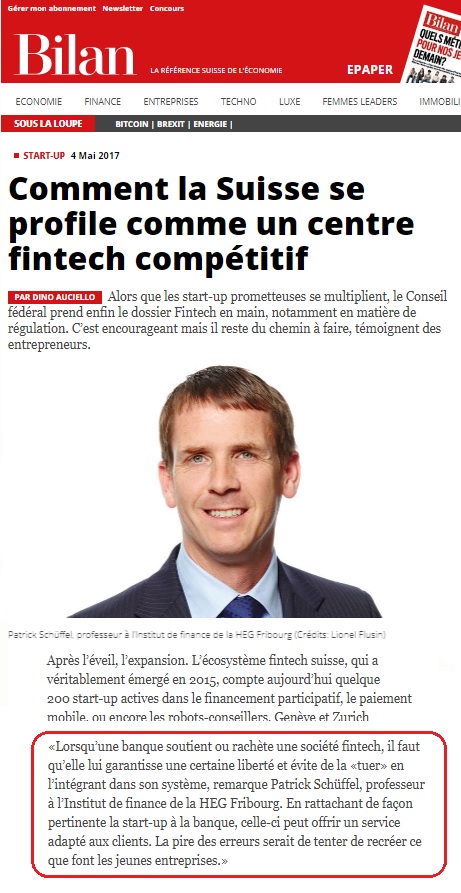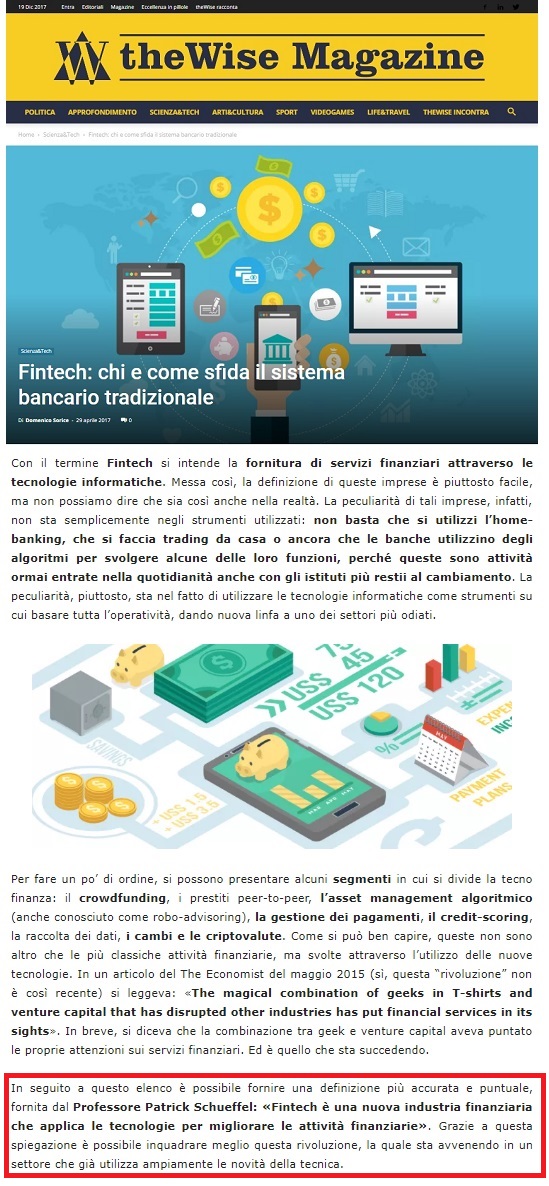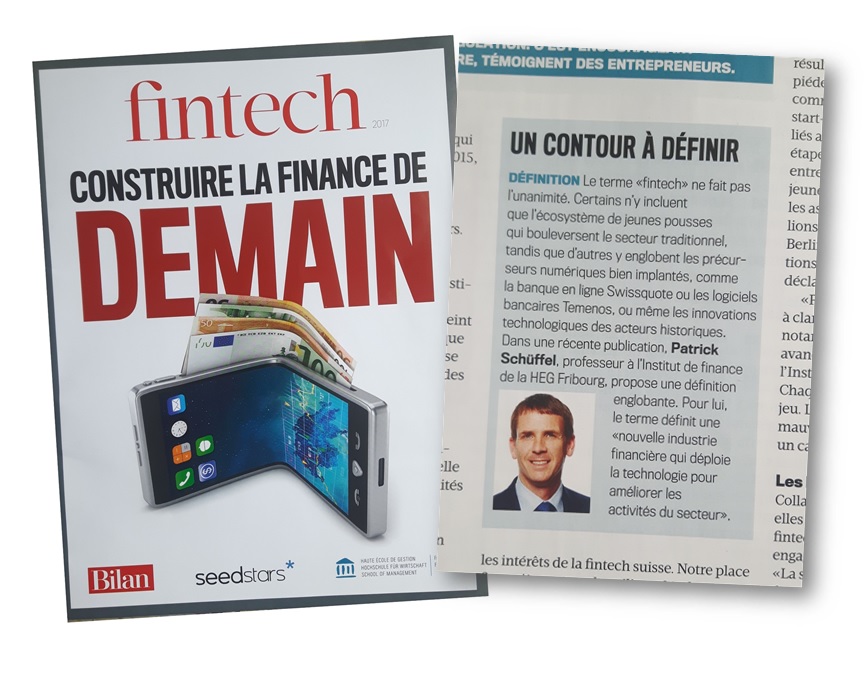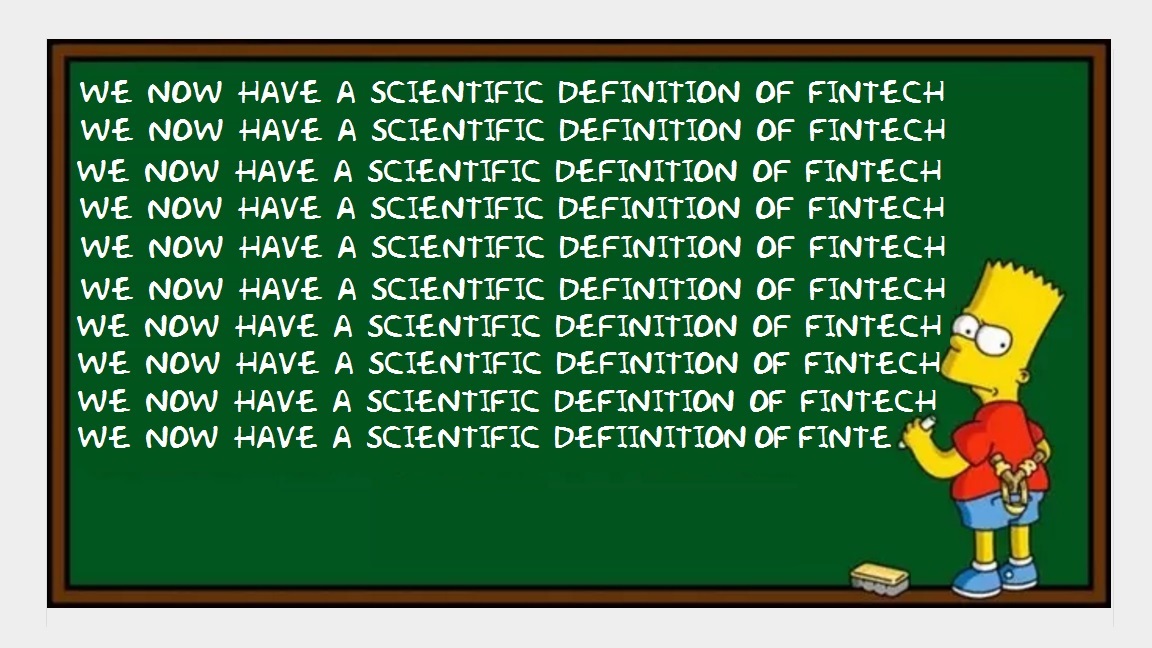Excerpt from:
Tech Magazine
Special Edition 2017
p. 8 & 9
Dr. Patrick Schüffel, Professsor, Institute of Finance, Haute école de gestion, Fribourg Chemin du Musée 4, CH-1700 Fribourg, patrick.schueffel@hefr.ch,www.heg-fr.ch
Excerpt from:
Tech Magazine
Special Edition 2017
p. 8 & 9
Dr. Patrick Schüffel, Professsor, Institute of Finance, Haute école de gestion, Fribourg Chemin du Musée 4, CH-1700 Fribourg, patrick.schueffel@hefr.ch,www.heg-fr.ch

Over the past years Fintech has transformed the way how the collection of dog taxes is being ensured in Switzerland. Modern technology, dogs, their owners, vets, the police, and tax authorities work hand in hand to safeguard the levying of dog dues. The result is a process that provides benefits to everyone involved.
For decades Switzerland has been known for its rather lenient approach to taxes. However, this certainly does not apply to dog taxes. Take, for instance, Zurich: 7’156 dogs peacefully coexist with the human population of the city. If you walk your dog on the streets of Zurich, you can be pretty sure to sooner or later bump into the taxman, or – to be more precise – into a dutiful policeman with a handheld RFID reader. Any dog kept in Switzerland must be examined, registered and chipped by a vet within three months from birth. The policeman checking your dog will then read out the data on the microchip which was subcutaneously implanted in your canine. A wireless connection is established from the RFID device to the AMICUS database in the Swiss capital Berne where all dogs of Switzerland are supposed to be registered. Should the dog be listed in the city of Zurich, the policeman can furthermore access the database of the municipality to verify in real-time whether you have already paid your dog dues. If not, you may be fined on the spot.
Benefits of a digital monitoring process
This system has three major advantages over the previously used dog tags that you put on the dog’s collar in order to prove that you paid your taxes: First, there is no more hassle with physical badges. Second, the system works highly efficient as it runs online and in real-time. And third, as it operates in real-time and as the chip serves as a unique identifier of the dog, it is virtually impossible to dupe the system.
Next to these advantages, there are several other advantages, such as the easy identification of the owner of a stray dog, even if the dog wears no collar. Moreover, dog trafficking from puppy mills abroad is severely hampered by this system. But most importantly, the vaccination record of the animal is also linked to the unique identifier of the dog’s microchip, so that meddling with vaccination histories is prevented.
Pervasive Fintech solution
The Fintech dogs of Switzerland are yet just another example how pervasive Fintech has become in the meantime. In this case it did not come as a revolutionary big bang, but it slowly moved into the everyday’s lives of all Swiss dog owners. It was painless process for all stakeholders (except for the dog who feels a sting when the chip is being implanted) and it yielded unprecedented efficiency and safety levels. Moreover, this example is not yet another Fintech showcase, but more specifically a RegTech and TaxTech example that provided all stakeholders with additional benefits.
Let us just hope that this system will not be taken to the extreme and that humans will be spared of getting a microchip implanted for tax purposes.
Dr. Patrick Schüffel, Professor, Institute of Finance, Haute école de gestion Fribourg, Chemin du Musée 4, CH-1700 Fribourg, patrick.schueffel@hefr.ch / www.heg-fr.ch

The full article can be accessed here. (French only)
Dr. Patrick Schüffel, Professsor, Institute of Finance, Haute école de gestion Fribourg, Chemin du Musée 4, CH-1700 Fribourg, patrick.schueffel@hefr.ch, www.heg-fr.ch
I am honoured to see that my definition of Fintech is also increasingly being used in Italian.

To access the entire article click here.
Dr. Patrick Schüffel, Professsor, Institute of Finance, Haute école de gestion Fribourg, Chemin du Musée 4, CH-1700 Fribourg, patrick.schueffel@hefr.ch, www.heg-fr.ch

Avec son numéro d’avril 2017, le journal suisse «Bilan» a récemment publié un supplément sur Fintech en Suisse. J’étais ravi de constater que l’éditeur a cité ma définition de Fintech, précédemment publiée dans le Journal of Innovation Management. Comme la publication originale était en anglais, la traduction française publiée par Bilan est la suivante:
«Fintech est une nouvelle industrie financière qui déploie la technologie pour améliorer les activités financières.»
(Patrick Schueffel tel que cité par Comment la suisse se profile comme un centre Fintech compétitif, Bilan 4/2017, supplément Fintech – Construire la finance de demain, p.6)
Pour votre référence, prenez également note de la version originale en anglais de la définition qui a été publiée dans l’article scientifique suivant: Schueffel, P. (2016). Taming the Beast: A Scientific Definition of Fintech. Journal of Innovation Management, 4(4), 32-54.
“Fintech is a new financial industry that applies technology to improve financial activities”(Schueffel, 2016; p. 45)
Dr. Patrick Schüffel, Professsor, Institute of Finance, Haute école de gestion, Fribourg Chemin du Musée 4, CH-1700 Fribourg, patrick.schueffel@hefr.ch,www.heg-fr.ch
I am proud to now also be cited in Chinese media outlets in the context of Fintech – alongside with Bill Gates! 😉

The full article can be accessed here.
Dr. Patrick Schüffel, Professsor, Institute of Finance, Haute école de gestion Fribourg, Chemin du Musée 4, CH-1700 Fribourg, patrick.schueffel@hefr.ch, www.heg-fr.ch

Kürzlich erschien in der englischsprachigen Fachzeitschrift Journal of Innovation Management mein Artikel zur Definition des Begriffs Fintech: Schueffel, P. (2016). Taming the Beast: A Scientific Definition of Fintech. Journal of Innovation Management, 4(4), 32-54.
Nach der Durchsicht von über 200 wissenschaftlichen Artikeln, die im Verlaufe der vergangenen 40 Jahre erschienen und in welchen das Wort Fintech benutzt wurde, hatte ich in diesem Artikel die folgende Definition des Begriffs Fintech abgeleitet:
“Fintech is a new financial industry that applies technology to improve financial activities” (Schueffel, 2016; p. 45)
Da der Artikel ausschließlich auf Englisch veröffentlicht wurde, erreichten mich zwischenzeitlich zahlreiche Anfragen, wie diese Definition ins Deutsche zu übersetzen sei. Gerne möchte ich diese Frage mit der folgenden deutschen Definition beantworten:
„Fintech ist eine neue Finanzindustrie, welche Technologie verwendet, um finanzielle Aktivitäten zu verbessern.“
Mit besten Grüssen
Patrick Schüffel
Dr. Patrick Schüffel, Professsor, Institute of Finance,
Haute école de gestion Fribourg
Chemin du Musée 4
CH-1700 Fribourg
patrick.schueffel@hefr.ch
www.heg-fr.ch

“Fintech is a new financial industry that applies technology to improve financial activities.” (Schueffel, 2016; p. 45)
This is the definition I derived after examining more than 200 scholarly articles that were published over a period of 40 years and which are referencing the word Fintech in one way or the other. Building on the commonalities of the definitions that found entry into those peer-reviewed journals I distilled the definition provided above.
I am proud that my work withstood the rigorous double-blind peer review process of the Journal of Innovation Management and was published these days.
As the Journal of Innovation Management is an open access journal you can retrieve the full text by using the following link:
http://www.open-jim.org/article/view/322
A big thank you goes out to the two anonymous
reviewers for their highly constructive comments and to the editors of the Journal of Innovation Management, Anne-Laure Mention, João José Pinto Ferreira and Marko Torkkeli!
Schueffel, P. (2016). Taming the Beast: A Scientific Definition of Fintech. Journal of Innovation Management, 4(4), 32-54.
Dr. Patrick Schüffel, Professsor, Institute of Finance, Haute école de gestion, Fribourg Chemin du Musée 4, CH-1700 Fribourg, patrick.schueffel@hefr.ch,www.heg-fr.ch
 Seasoned private bankers often do not grasp the idea of the Blockchain. It was not until I understood that I was using the wrong vocabulary that I could convey what the Blockchain was all about.
Seasoned private bankers often do not grasp the idea of the Blockchain. It was not until I understood that I was using the wrong vocabulary that I could convey what the Blockchain was all about.
Have you even tried to explain the Blockchain concept to a seasoned private banker? Have you tried to describe the notion of a distributed ledger to this type of auditorium? And have you experienced the same result as I have over and over again: have you, too, just banged your head against a brick wall? I pondered the question why it was so much harder to explicate the concept to alleged banking experts than to first-year business students.
Use the right vocabulary
After numerous futile explanation attempts, it dawned on me. I was using the wrong vocabulary. Using the word ledger is counterproductive to the cause. When talking about a ledger, the traditional banker immediately translates that term into “bankbook” and that is the book in which the bank keeps all records of all customers adding and taking money from their bank accounts. It is thus the holy grail of private banking. Distributing the holy grail is inconceivable to many a private banker.
At that point it then hardly matters if you continue to explain that the users of the Blockchain are typically anonymized. It is almost futile to further explicate that, for instance, Bitcoin accounts are not tied to the identity of users and that anyone can create new and completely random Bitcoin accounts at any time, without the need to submit any personal information to any party. You have lost them already. Hence, what I found helpful in this situation is to refrain from using the term “ledger” altogether. Instead I call it distributed data base or distributed accounting system.
Give them a hands-on example
A friend of mine and design thinking pioneer, Michael Lewrick recently recommended me to do a hands-on exercise in particularly tough cases. Individually assign a random yet different number to every one of the ten bankers that are sitting in a room with you and have each of them note down their number and favourite colour on a separate sheet of paper. Have them pass on the paper to another participant and everyone repeats the exercise. Do so altogether ten times. In the end, everyone holds a list of 10 numbers and favourite colours in their hands. At this stage you can ask a) “What is Bob’s favourite colour?” – the others shouldn’t be able to tell as Bob’s identity has been anonymized. Yet you can also ask Bob, whether the correct colour is listed on his sheet – which should clearly be the case. And b) you can ask someone to now commit a “fraud”, i.e. to change the favourite colour of one participant – which should be nearly impossible unless the tasked fraudster does so on ten sheets of paper with the nine remaining group members agreeing. This exercise nicely explains some of the key features of the Blockchain and monies based thereon.
It’s worth trying
These two measures combined, using audience specific language and a hands-on exercise should therefore do the job. It certainly deserves a try. The Blockchain concept is too important as we could afford leaving private bankers behind. Happy explaining!
Dr. Patrick Schüffel, Professsor, Institute of Finance, Haute école de gestion, Fribourg Chemin du Musée 4, CH-1700 Fribourg, patrick.schueffel@hefr.ch, www.heg-fr.ch

The number and diversity of Fintech offerings is soaring. As banking clients increasingly often enjoy not only a better user experience, but also cheaper rates at Fintech firms, their willingness to be locked-in with one or two universal banks diminishes. Henceforth clients will gradually assemble their own individual “banks”, comprising a range of offerings from different Fintech companies. Those firms which will be able to provide an overarching structure to seamlessly wrap the multitude of Fintech offerings will experience their heydays.
Modern production technology allows what would have been inconceivable only a few decades ago. If we want, we can have products of mass production tailored to our needs nowadays. Dell made only the beginning when first assembling PCs to our requests on a large scale. Today we order our tailored sneakers at Nike ID, wear a unique t-shirt from Spreadshirt and eat M&M’s sporting our very own initials. Yet, the trend of mass customization did not stop in the manufacturing sector. We can already observe its ramifications in the financial services industry where Robo-Advisors offer retail customers to tailor their client portfolios. But this is not the end point of the evolution. It is the mere beginning which will eventually lead to tailored banks.
Like it or not, every single one of us carries his or her own very personal balance sheet: On the asset side, we have liquid asset positions such as the cash that we have in our wallets, the money on our current accounts, our savings accounts or money market instruments. Our personal investments may comprise medium term notes, bonds, stocks, mutual funds, pension savings and/or alternative Investments. Finally, we may possess highly illiquid real estate investments such as our primary residences, vacation homes or even property that we rent out.
On the liability side we may also have a variety of items. Current liabilities may include unpaid bills, credit card balances, taxes due, installment loans due in the short run, consumer loans, car loans, student loans, mortgages due within one year etc. Non-current liabilities may include any consumer, car or student loan that is due after one year. Last but not least, we may have mortgage debt for our primary residence and/or vacation homes and/or rental property.
Hence, as individual as we are as human beings, as individual are our personal balance sheets. Yet, what we do have in common is that we willingly or unwillingly manage these balance sheets. We carry out treasury functions on our personal balance sheets by paying bills and installments, transferring money from one account to another, by investing in shares or by redeeming mutual funds etc.
So far many consumers in the western world have ties to one or two banks, oftentimes universal banks, that cater to all of the needs resulting from these treasury transactions. Yet, the service offerings of universal banks are increasingly rivaled by Fintech firms that offer a narrow, yet highly specialized service or product.
If you have a little cash to spare, Fintech firms such as Creditgate24, LendingClub or Crowdcube, have offerings for optimizing liquid assets. To manage longer term investments one can turn to providers such Wealthfront, Moneyfarm, Nutmeg, Addepar etc. On the liability side, too, there is a vast array of Fintech companies jockeying for position. Current and medium term liabilities may be optimized by using Affirm, Borro, Lendable, Prosper etc.
In order to transfer money from one provider or account to another the consumer can chose among dozens of payment providers such as TransferWise, LiquidPay, Paypal and the likes. For trading purposes the client may want to turn to eToro or Robinhood. Even donating money becomes easier and less burdensome with Fintech providers such as Elefunds.
These new type of financial services providers that found their niches on specific links of the value chains of universal banks typically not only promise their clients a better user experience, but also lower costs. What is thus foreseeable for the near future is that clients will no longer accept to be locked-in with one or two banks, but that they will make use of a range of financial service providers. Eventually every user will assemble his or her very own bank, the IBank* as I call it.
The IBank will comprise a selection of services provided by specific Fintech companies handpicked by the individual client. This can happen dynamically and on an ad-hoc basis or on a more permanent base. The client – or an overlaying algorithm for that matter – may decide on a case-by-case basis which payment service would be optimal for a specific transfer. On a more longer term basis one mortgage provider may be chosen until the renewal of the mortgage is due.
What is important to note, however, is that clients will make use of tailored “banks” which may be as personal as their individual balance sheet. The challenge and opportunity in this future banking world will be to provide the glue that seamlessly keeps together these services provided by different providers. Those providers who manage to assemble and maintain an overarching structure that smoothly integrates the multitude of service offering of Fintech providers will have a bright future in finance services world which is being ever more atomized.
*IBank like “I bank” – not to be mistaken with the iBank offerings by Barclays, The Bank of Georgia, Fransabank, BCU and so on.
Dr. Patrick Schüffel, Professsor, Institute of Finance, Haute école de gestion, Fribourg Chemin du Musée 4, CH-1700 Fribourg, patrick.schueffel@hefr.ch, www.heg-fr.ch